Spelt sourdough bread has a wonderful crusty exterior and chewy crumb. This no-knead bread starts with ancient grains and is super easy to make. You can easily prepare multiple loaves and store in the fridge to bake hot bread for dinner throughout the week.
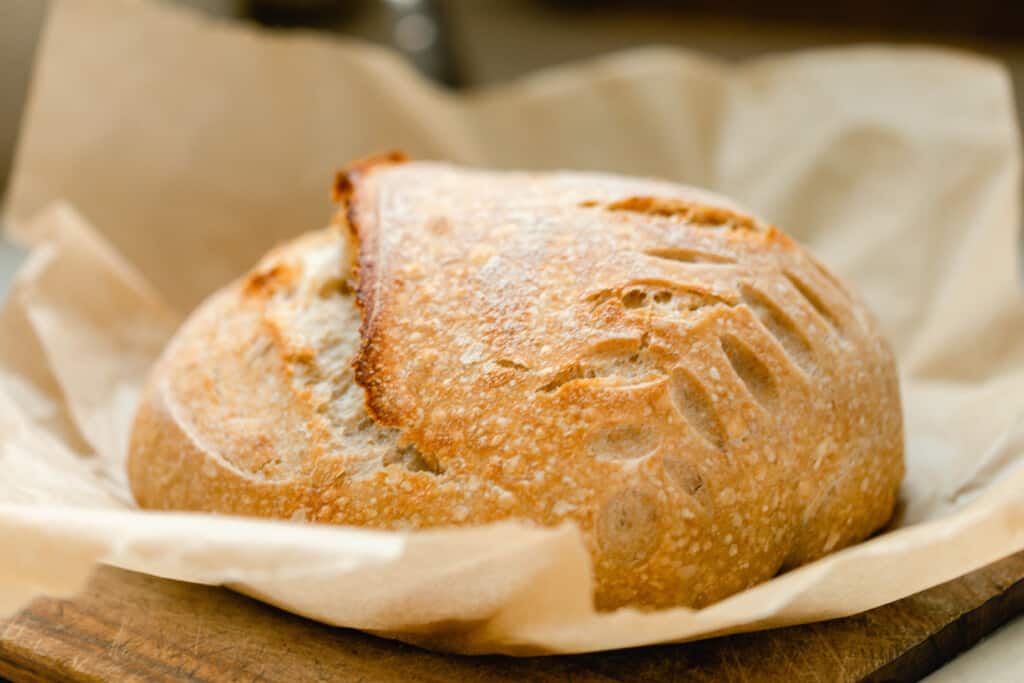
This recipe is a great way to incorporate whole grains and ancient grains into your diet. It is a lot like my no-knead sourdough bread, but I wanted to use mostly spelt rather than all-purpose flour.
It is also much easier to work with than einkorn flour and can be substituted one for one (may have to reduce the liquid a tad bit) in most recipes calling for all-purpose flour.
Sourdough bread with spelt flour has a lovely flavor and texture that is pretty similar to regular bread. The crusty exterior makes it ideal for bruschetta, dipping in soup, hot sandwiches, etc.
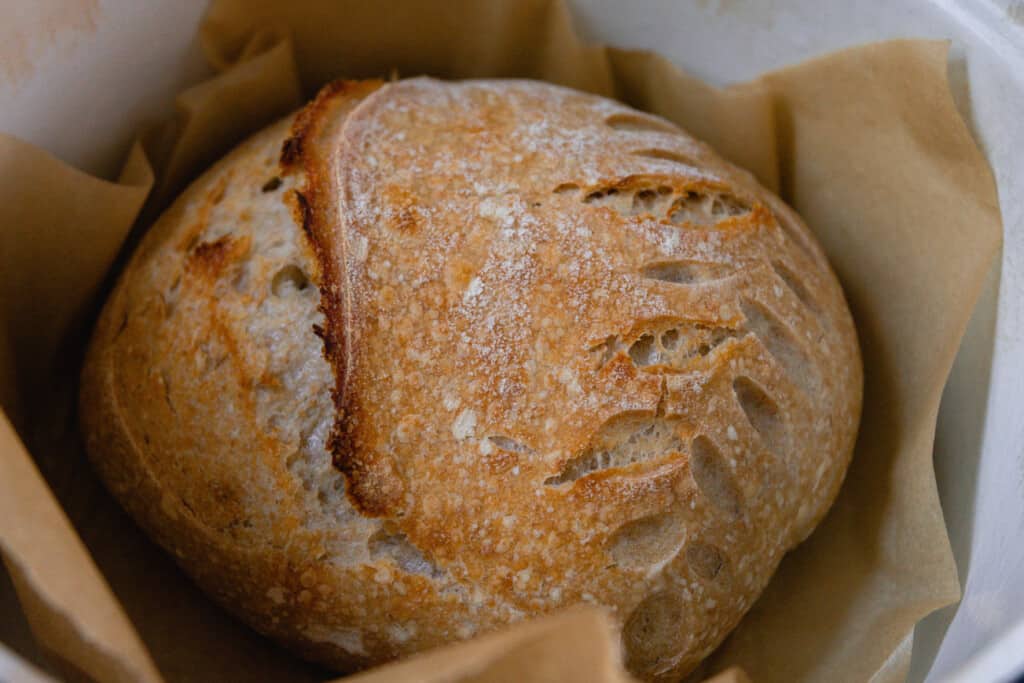
What Is Spelt Flour?
Spelt an ancient whole grain wheat that acts most similarly to all-purpose flour, but has a slightly lower gluten content. Spelt is milled with the bran on, making it a whole wheat flour. It has a wonderful, slightly nutty flavor that lends itself well to breads, muffins, cookies, and more.
Spelt is a healthy flour, packed with fiber, iron, B vitamins, magnesium, zinc, and phosphorus. It also has a higher protein content compared to wheat flour.
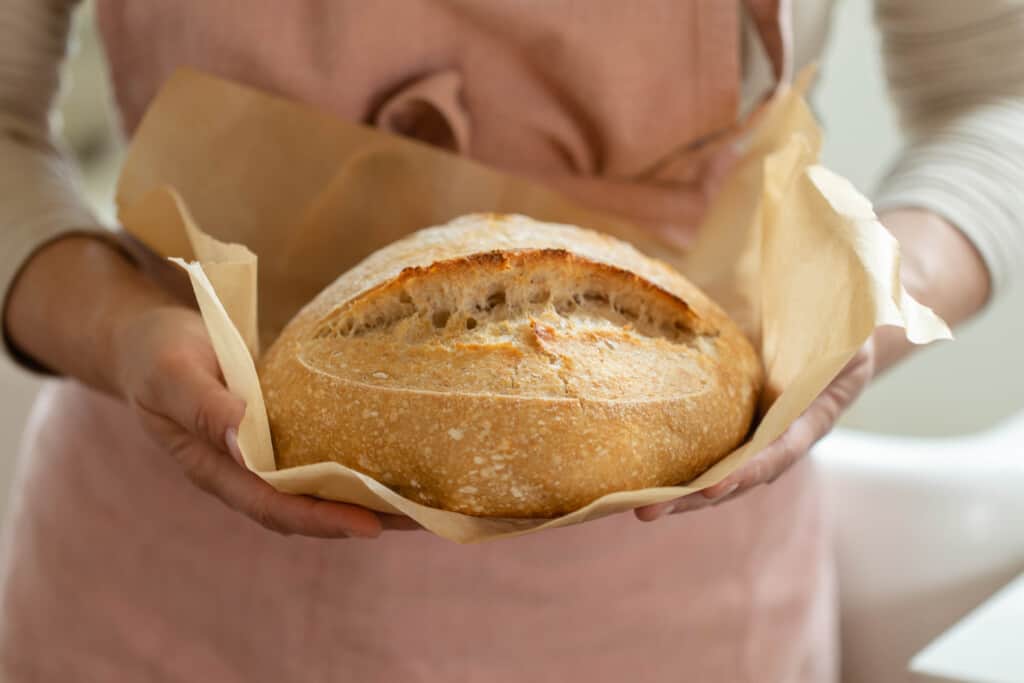
Tips:
I like the mix of whole spelt and white spelt, but you can sub one or the other for all of the spelt component if that is all you have.
Dip your hands in water if the dough is too sticky while doing the stretch and folds.
This post contains affiliate links, which means I make a small commission at no extra cost to you. See my full disclosure here.
FAQ:
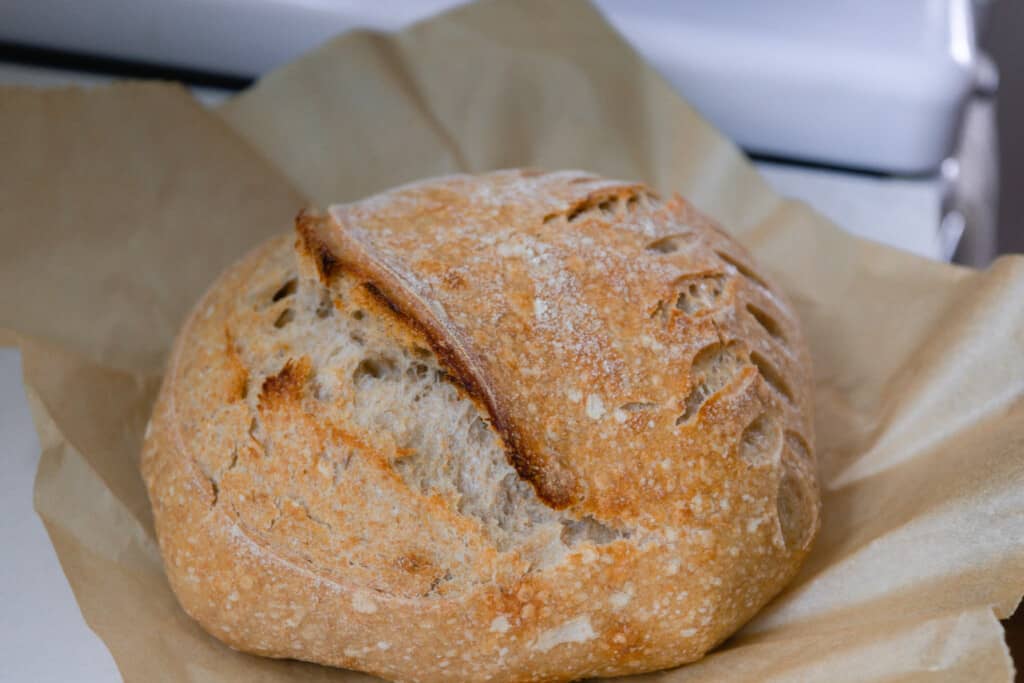
Is spelt good for making sourdough?
Yes. It adds a wonderful flavor and it produces a moister loaf. It also acts really similarly to all-purpose flour.
What does spelt sourdough mean?
It is sourdough bread made with spelt flour.
Can I use spelt flour in my sourdough starter?
Yes. You can easily feed your starter spelt flour without any issue.
Does Spelt sourdough bread have gluten?
Spelt sourdough bread does have gluten, but the gluten is more broken down compared to regular bread, which may help with digestion. Those that are gluten sensitive may be able to tolerate sourdough bread.
If you have celiac disease, you will still not be able to consume any sourdough unless it is gluten free sourdough.
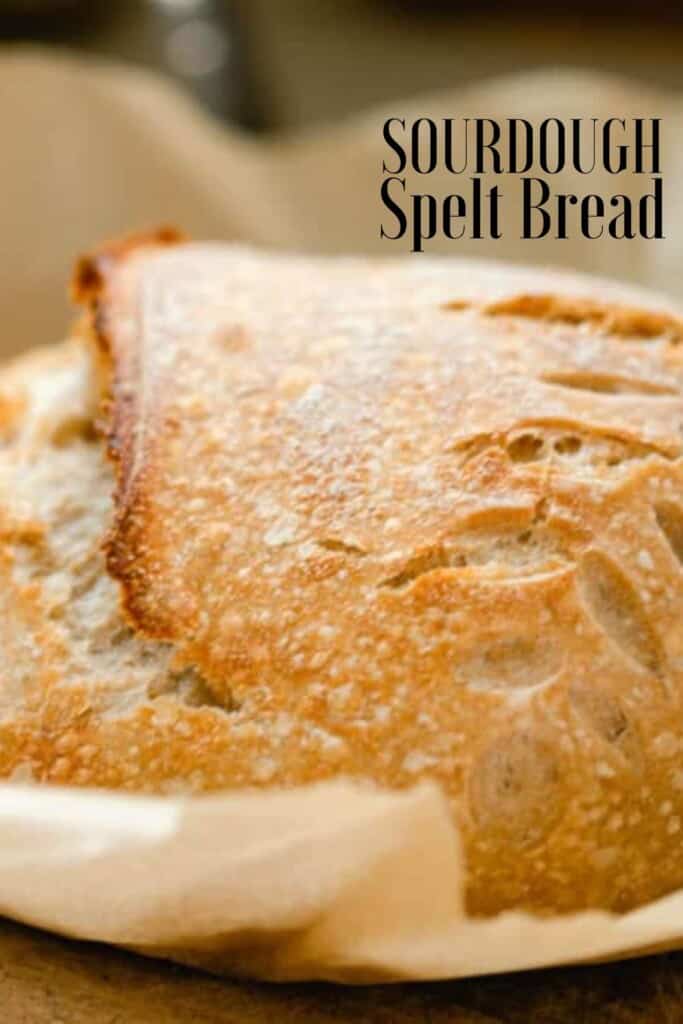
Spelt Sourdough Bread Ingredients:
Bread flour – This helps keep the structure of the bread, since spelt has less gluten content than regular wheat.
White spelt – Spelt flour that has had the germ and bran removed, leaving it with a finer flour.
Whole spelt – Typically what you will find in the store, containing the germ and the bran.
Sourdough Starter – This is sourdough starter that is super active and bubbly. This will ensure you will get the best rise.
Water
Salt
Tools You Make Need:
Parchment paper
Banneton basket, basket with a tea towel, or a bowl with a tea towel.
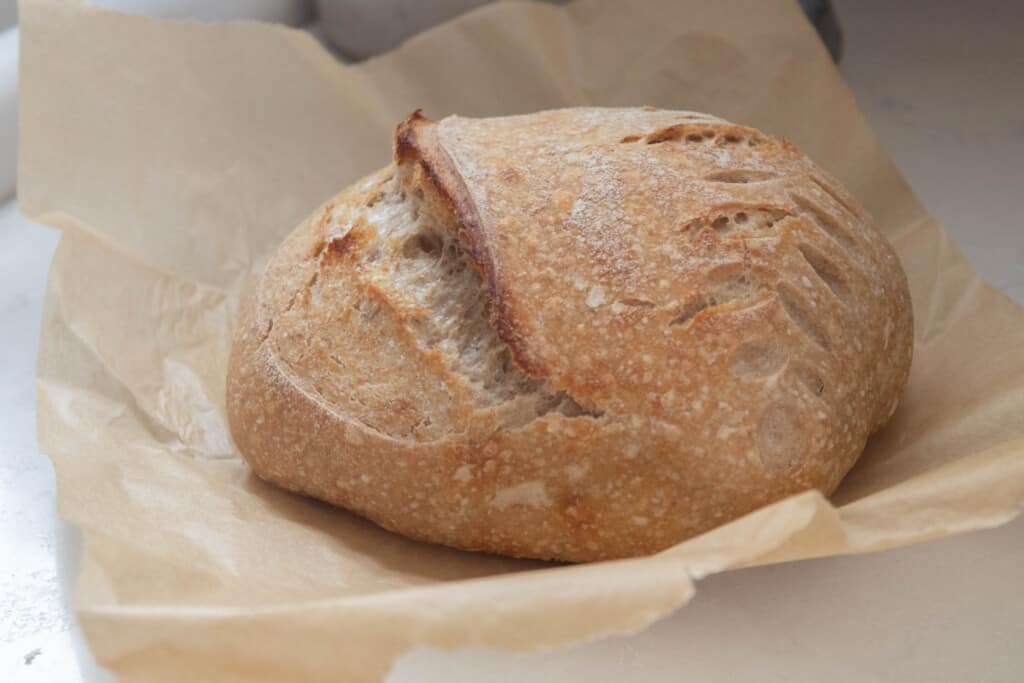
How To Make Spelt Sourdough Bread:
Feed a sourdough starter 4-12 hours before starting the bread, ensuring it is active and bubbly.
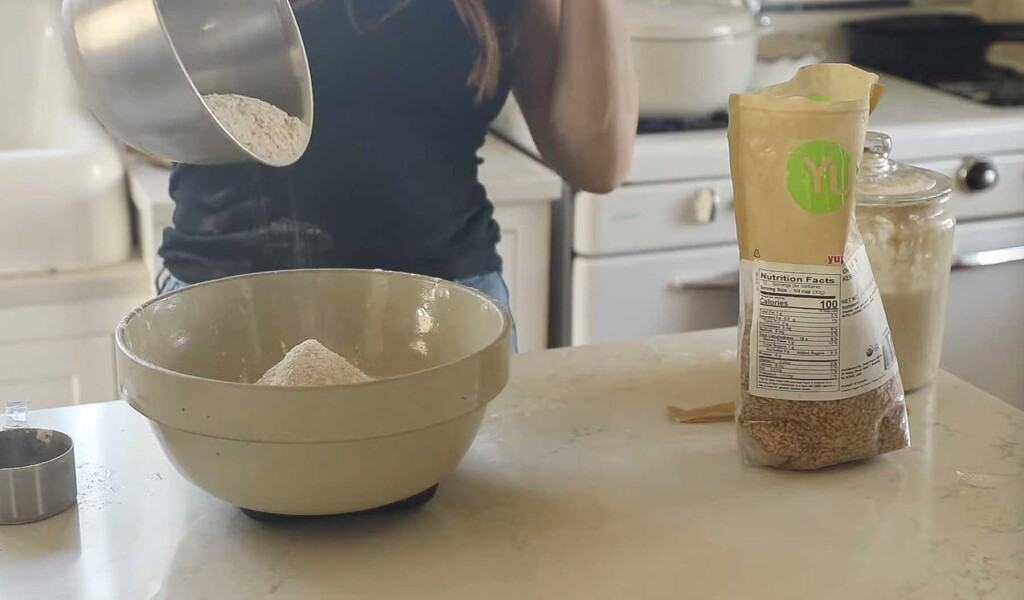
To a large bowl, add warm water, flours, sourdough starter, and salt.
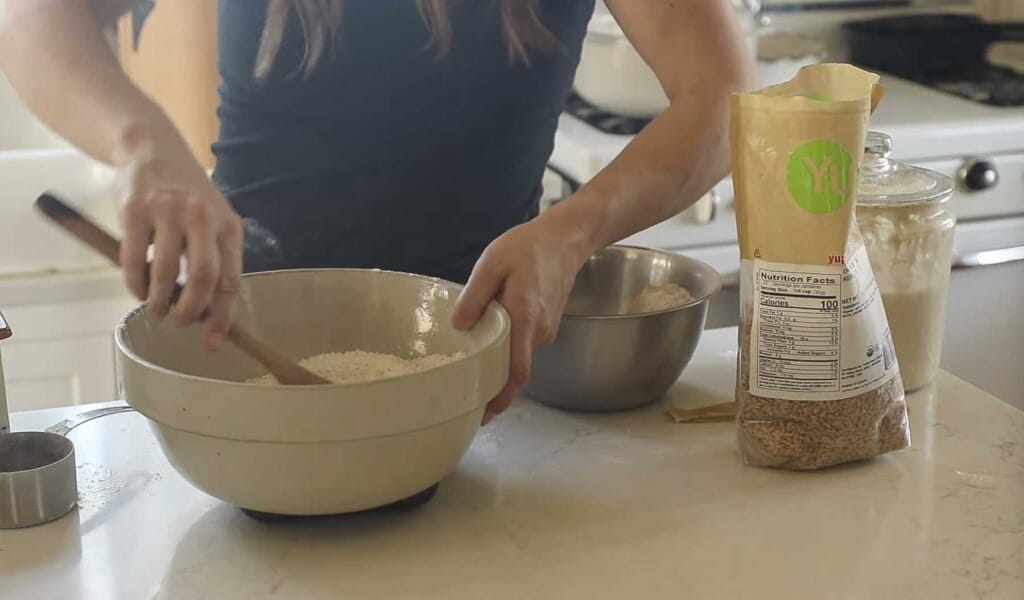
Stir until well combined.
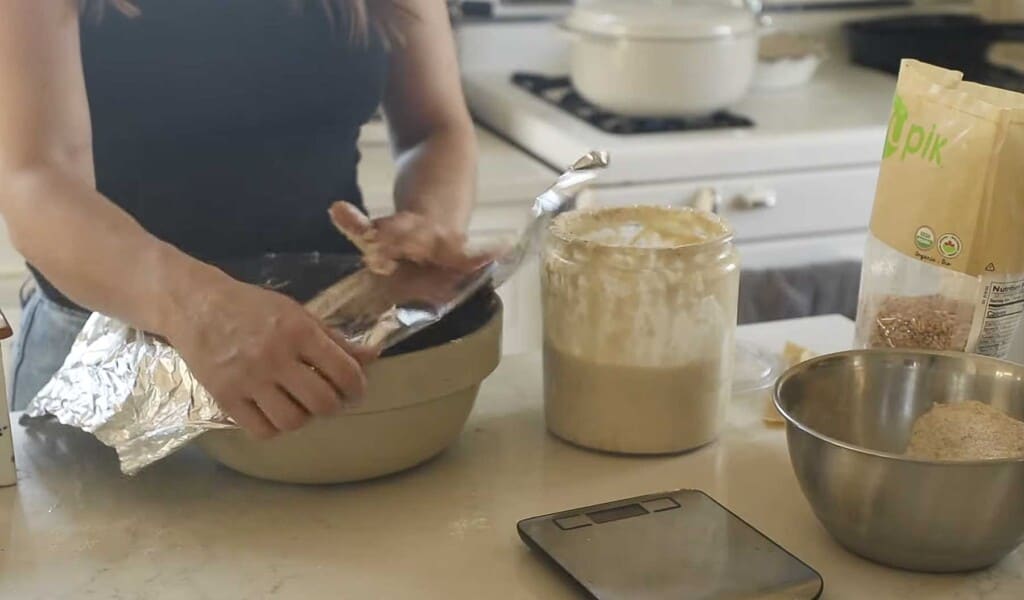
Cover with damp towel, lid, or plastic wrap while resting. Allow to rest for 30 minutes for the water to hydrate the flour. This process is called autolyse. It allows all the flours to become hydrated.
Stretch And Fold
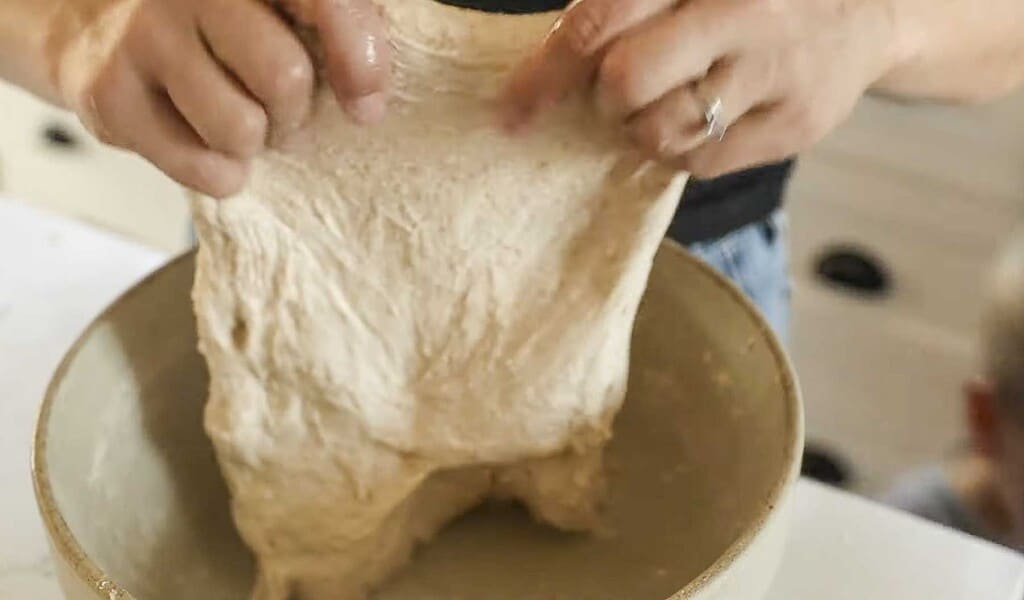
This is a no-knead recipe. Instead of kneading the dough, stretch and fold is performed.
Stretch and folds are accomplished by grabbing the edge of the dough firmly and pulling up, stretching it upwards. Then push the dough that is in your hands back into the center. Turn the bowl about a quarter turn and do this stretch and fold for a total of 3-4 times. This is considered one round of stretch and folding. Repeat for a total of 6 rounds.
First 3 stretch and folds – every 15 minutes.
Last 3 stretch and folds – every 30 minutes.
Cover with a wet towel or plastic wrap and allow the dough to bulk-ferment until doubled. This could be anywhere from 3-8 hours depending on the temperature and maturity of your sourdough starter.
Be careful not to over ferment the dough. Over fermentation leads to a sticky dough that doesn’t rise. You lose all the shape and structure of the bread.
Shape The Dough
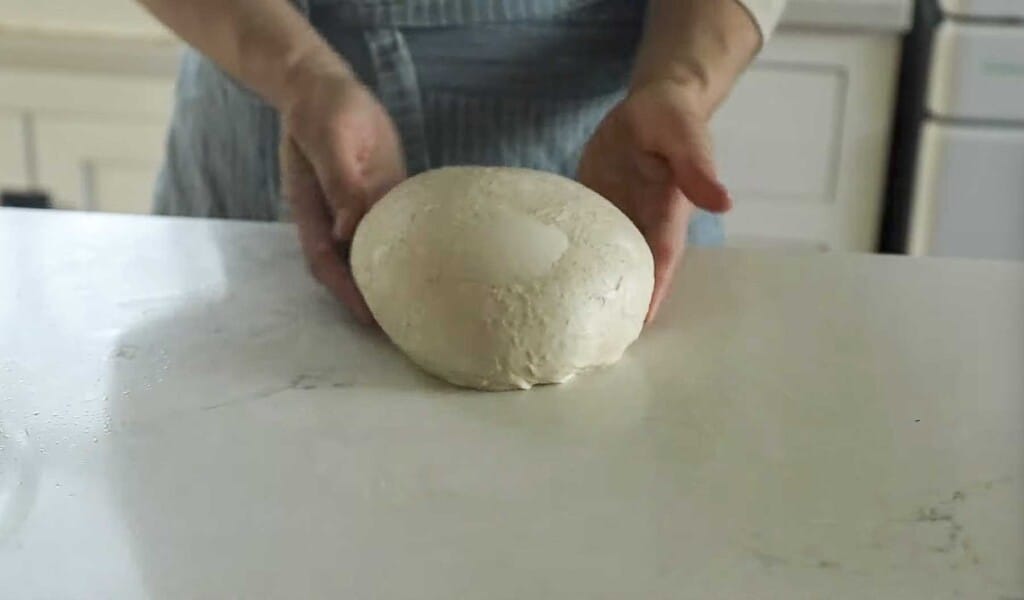
Shape the dough into a ball by gently spinning it toward you.
Set out 20-30 minutes uncovered on the counter. This allows the surface to develop a skin, so that it doesn’t stick to the tea towel or banneton basket during the overnight rise.
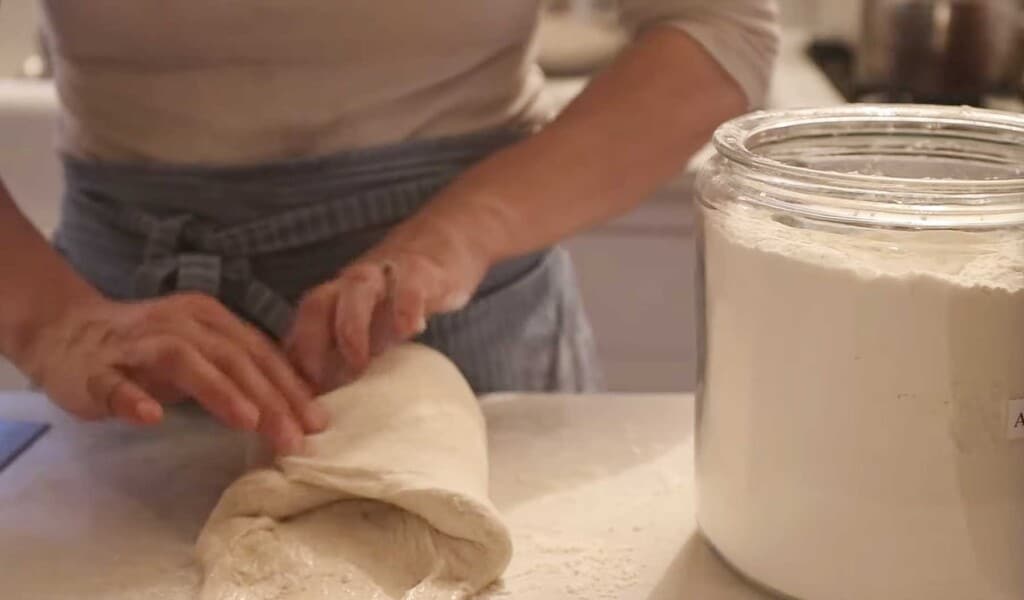
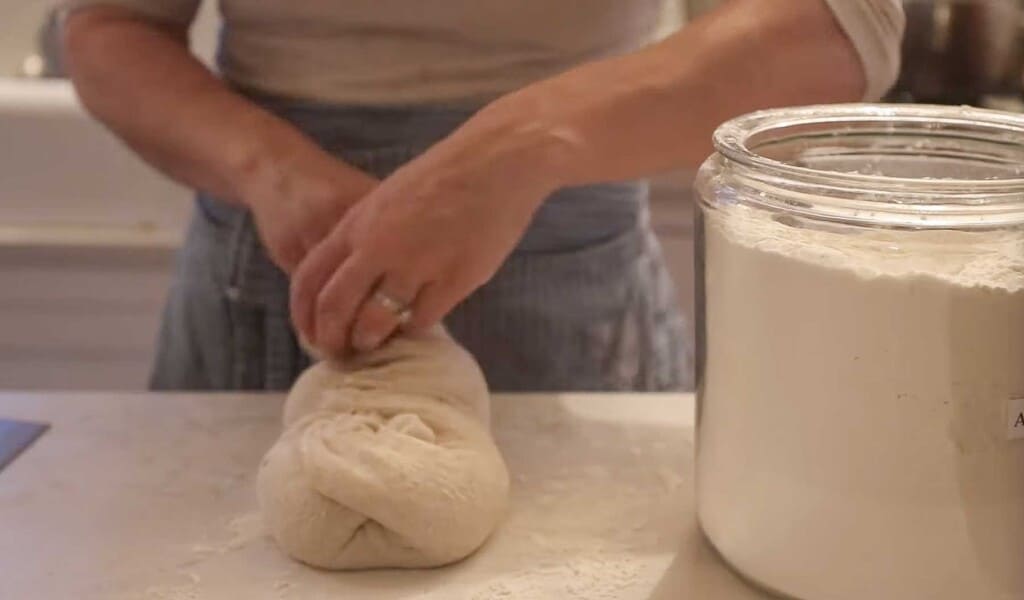
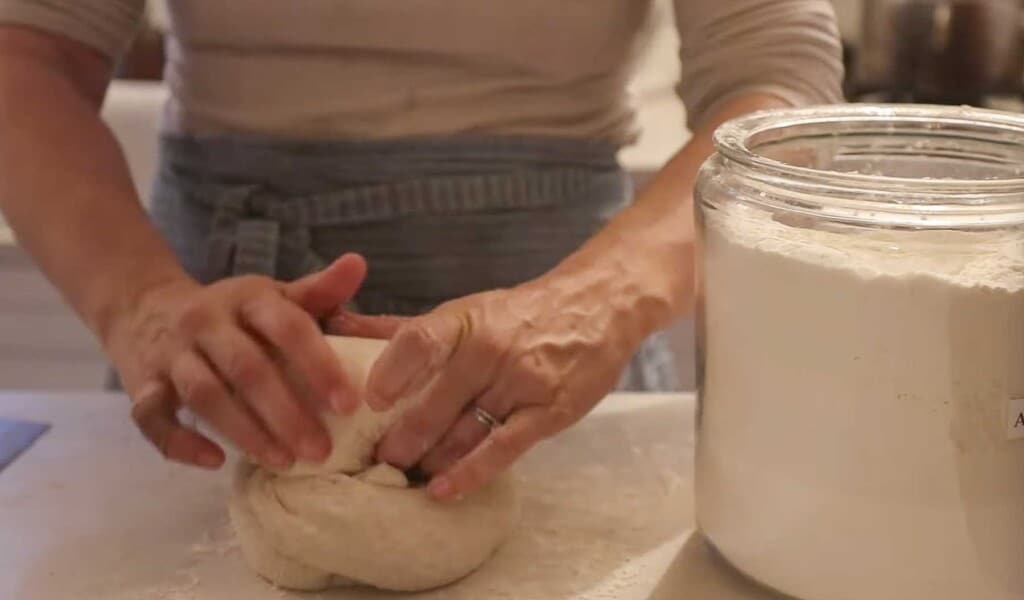
Turn over the dough (the skin that just developed down) onto a lightly floured surface and shape. I pull each side and fold into the dough, then pull the dough into a shoelace pattern (see video) and roll up.
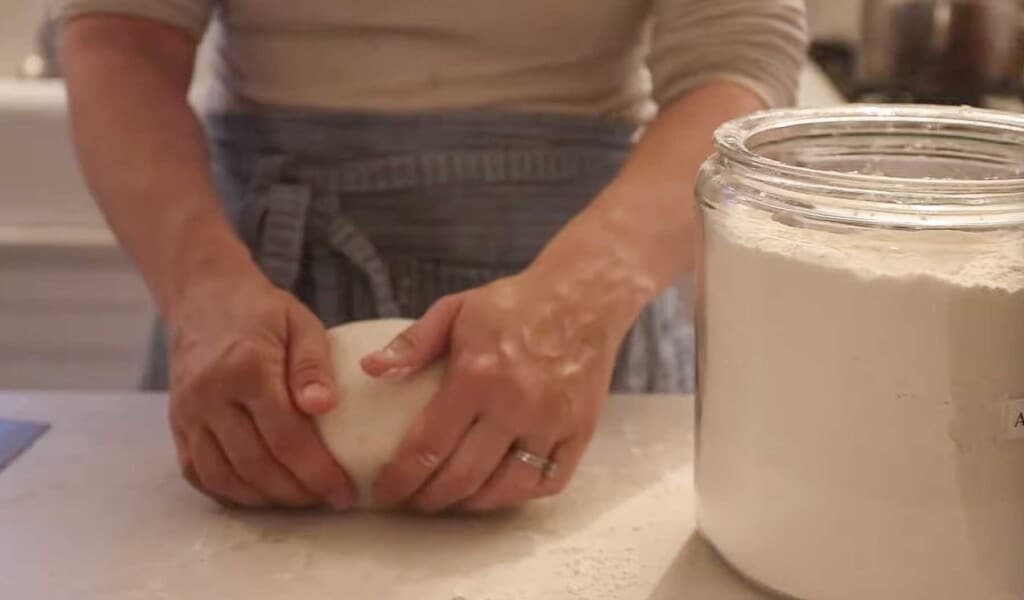
Gently pull the dough against the countertop towards you.
This is the part where you can really get a lot of structure in your final product. It’s easy to get those bubbles and big “ear” when you’re baking it, so you don’t want to skimp on this step.
Transfer to a floured banneton or bowl with tea towel, seam side up. Cover with plastic (I usually use a plastic grocery bag) and proof 12-15 hours (or overnight) in refrigerator. You can actually leave the dough for a couple of days.
Bake
Preheat dutch oven to 500 degrees for 1 hour.
Remove dough from the fridge immediately before scoring and baking.
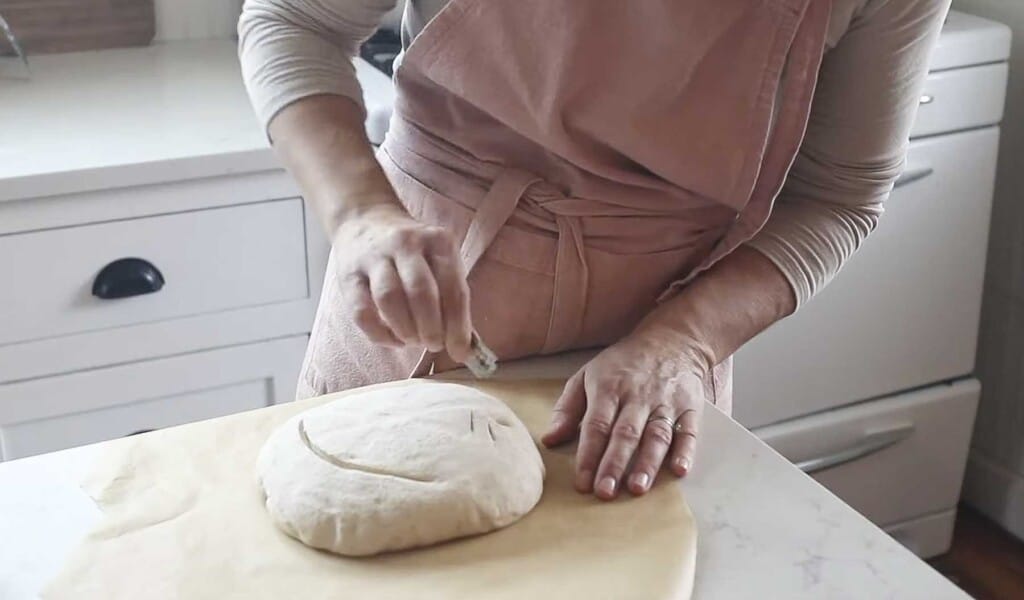
Turn over on parchment paper.
Dust with flour on top to make the scoring pattern stand out more. Optional.
Score with a razor.
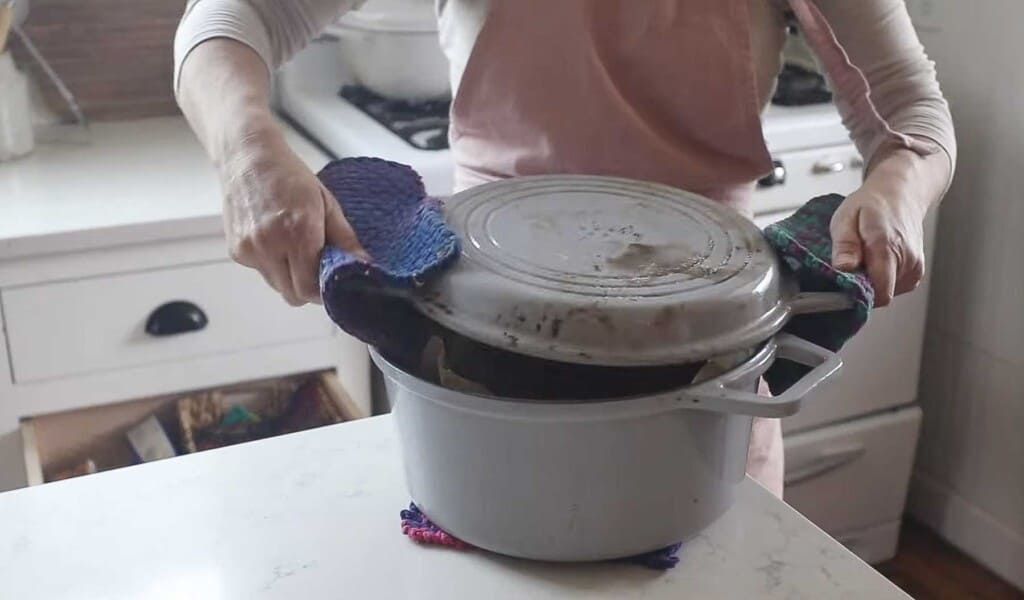
Place the parchment paper and dough into the preheated dutch oven and add lid
Place the dutch oven into the oven and turn down the heat to 475.
Bake for 20 minutes with lid on.
Take lid off and bake for another 20 minutes or until golden brown.
Storage:
Uncut bread can be stored in a paper or linen bag. Once cut, store cut side down on a cutting board lightly covered or in a storage bag.
Baker’s Schedule:
8 am: Feed sourdough starter with flour and water.
12 pm: If sourdough starter is mature, then proceed to creating the dough.
Combine the ingredients. Cover and rest for 30 minutes.
12:30 pm: Stretch and folds
First 3 stretch and folds – every 15 minutes
Last 3 stretch and folds – every 30 minutes
Cover with a wet towel or plastic wrap and allow the dough to bulk ferment until doubled.
8:00pm (may be much sooner or later depending): Shape dough.
Sit out 20-30 minutes, uncovered.
Turn over and shape.
8:30pm: Transfer to flour banneton or bowl with tea towel and cover with plastic. Place in the refrigerator for 12-15 hours.
The Next Day
9:00am: Preheat dutch oven on 500 for 1 hour.
10:00am: Take dough out of fridge, dust with flour, and score. Turn the oven down to 475, and bake for 20 minutes with the lid on, then 20 minutes without the lid.
Allow the bread to cool.
Find More Sourdough Favorites:
- Sourdough Oatmeal Cookies
- Best Sourdough Banana Muffins
- Sourdough Rye Bread
- Sourdough Pizza Dough
- Easy Sourdough Dinner Rolls
If you try this recipe and love it, I would love if you could come back and give it 5 stars!
Spelt Sourdough Bread
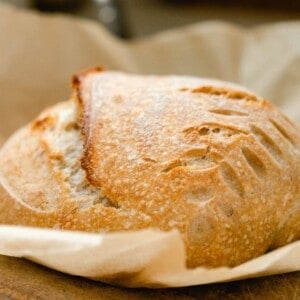
Ingredients
- 250 grams bread flour
- 175 grams white spelt
- 100 grams whole spelt
- 100 grams starter
- 325 grams water
- 10 grams salt
Instructions
- Feed a sourdough starter 4-12 hours before starting the bread, ensuring it is active and bubbly.
- To a large bowl, add warm water, flours, sourdough starter, and salt. Stir until well combined.
- Cover with damp towel, lid, or plastic wrap while resting. Allow to rest for 30 minutes for the water to hydrate the flour.
- Grab the edge of the dough firmly and pull up, stretching it upwards. Then push the dough that is in your hands back into the center. Turn the bowl about a quarter turn and do this stretch and fold for a total of 3-4 times. This is considered one round of stretch and folding. Repeat for a total of 6 rounds. * First 3 stretch and folds – every 15 minutes.
Last 3 stretch and folds – every 30 minutes. - Cover with a wet towel or plastic wrap and allow the dough to bulk-ferment until doubled. This could be anywhere from 3-8 hours depending on the temperature and maturity of your sourdough starter.
- Shape the dough into a ball by gently spinning it toward you.
- Set out 20-30 minutes uncovered on the counter.
- Turn over the dough (the skin that just developed down) onto a lightly floured surface and shape. I pull each side and fold into the dough, then pull the dough into a shoelace pattern and roll up.
- Gently pull the dough against the countertop towards you.
- Transfer to a floured banneton or bowl with tea towel, seam side up. Cover with plastic and proof 12-15 hours (or overnight) in refrigerator.
- The next day, preheat dutch oven to 500 degrees for 1 hour.
- Remove dough from the fridge immediately before scoring and baking.
- Turn over on parchment paper.
- Dust with flour on top to make the scoring pattern stand out more. Optional.
- Score with a razor.
- Place the parchment paper and dough into the preheated dutch oven and add lid
- Place the dutch oven into the oven and turn down the heat to 475.
- Bake for 20 minutes with lid on.
- Take lid off and bake for another 20 minutes or until golden brown.
- Allow to cool before slicing.
Notes
- I like the mix of whole spelt and white spelt, but you can sub one or the other for all of the spelt component if that is all you have.
- Dip your hands in water if the dough is too sticky while doing the stretch and folds.
Nutrition
Nutrition information is automatically calculated, so should only be used as an approximation.







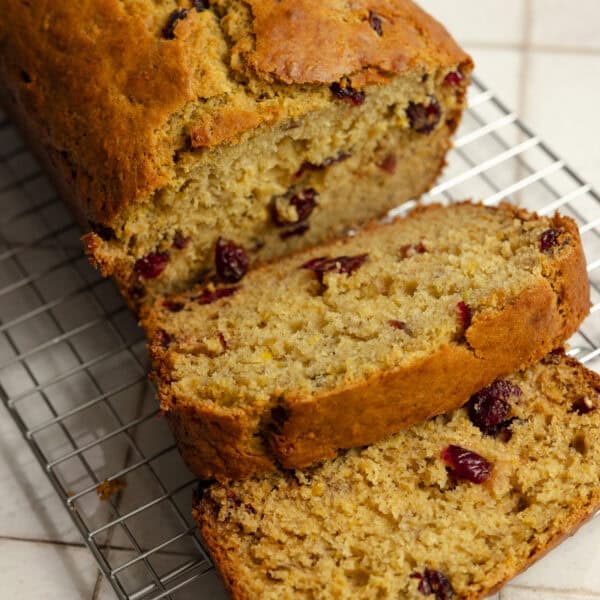

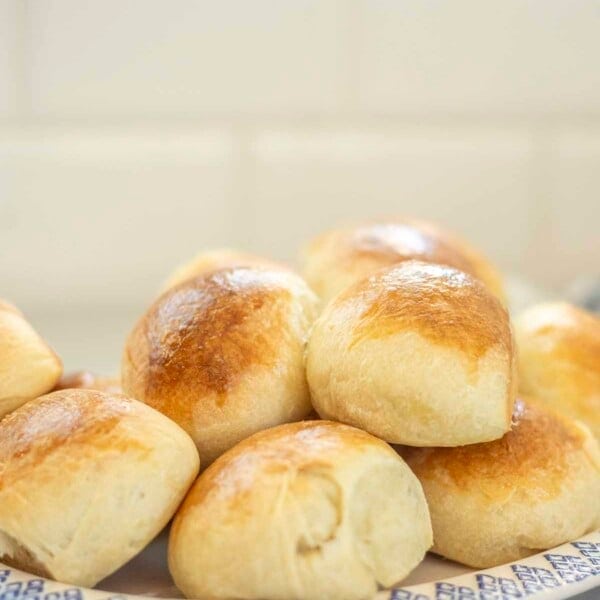






What kind of berries are you grinding for your *bread flour*?
Thank you,
Patty